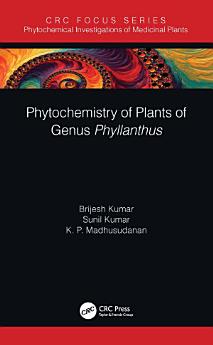Phytochemistry of Plants of Genus Phyllanthus
Par šo e-grāmatu
Features:
- Collection of Ayurvedic features and scientific evidence of important medicinal plants.
- Screening of major lignans, flavonoids and terpenoids in plant parts/whole plant extracts and their geographical variations in Phyllanthus amarus.
- Easy-to-use analytical procedure for the quality control of Phyllanthus and its products.
Par autoru
Dr. Brijesh Kumar is a Professor (AcSIR) and Chief Scientist of sophisticated analytical instrument facility division, CSIR-Central Drug Research Institute Lucknow. India. He has completed his PhD from CSIR-CDRI Lucknow (Dr. RML Avadh University Faizabad UP, India). Currently he is facility in charge at Sophisticated Analytical Instrument Facility (SAIF) division of CSIR-CDRI. He has to his credit more than 7 book chapters, three book and 145 papers in International journal of repute. His current area of research is applications of Mass Spectrometry tools (DART MS/Q-TOF LC-MS/4000 Q Trap LC-MS/ Orbitrap MSn) for qualitative and quantitative analysis molecules for quality control and authentication/standardization of Indian medicinal plants/parts and their herbal formulations. He is also involved in identification of marker compounds using statistical software to check adulteration/substitution.
Dr. K. P. Madhusudanan is a mass spectrometry scientist born in 1947 in Kerala, India. He obtained his doctoral degree in 1975 specializing in Organic Mass Spectrometry in National Chemical Laboratory, Pune, India. He worked as a scientist in Central Drug Research Institute, Lucknow until 2007. His research experience since 1970 includes various aspects of organic mass spectrometry such as fragmentation mechanism, gas phase unusual reactions, positive and negative ion mass spectrometry of natural products using various ionization techniques including DART, effects of metal cationization, LC/MS and MS/MS applications and quantitative analysis of drugs and metabolites. He authored more than 150 research publications. He was a member of the editorial board of Journal of Mass Spectrometry during 1995-2007. He is a fellow of the National Academy of Sciences, Allahabad, India. At present he lives in Kochi.
Dr. Sunil Kumar is currently working as an assistant professor at Ma Kanshiram government degree college, Farrukhabad, Uttar Pradesh, India. He has completed his Ph.D. under supervision of Dr. Brijesh Kumar on Application of Mass Spectrometric Techniques in Qualitative and Quantitative Analysis of Phytoconstituents and Identification of Chemical Markers by Chemometric Technique in Phyllanthus and Rauwolfia Spp. at mass spectrometry laboratory, sophisticated Analytical Instrument Facility at CSIR-Central Drug research Institute Lucknow. His research interest includes qualitative and quantitative analysis of phytochemicals using LC-MS/MS analysis.




